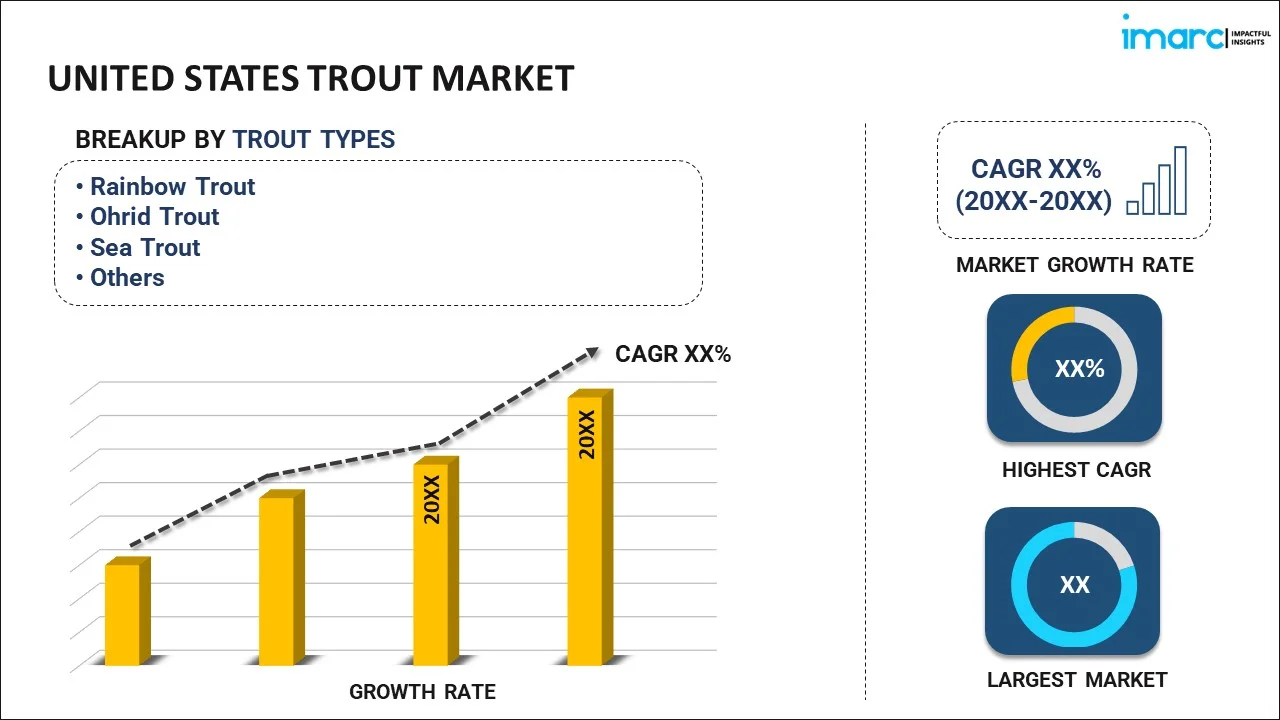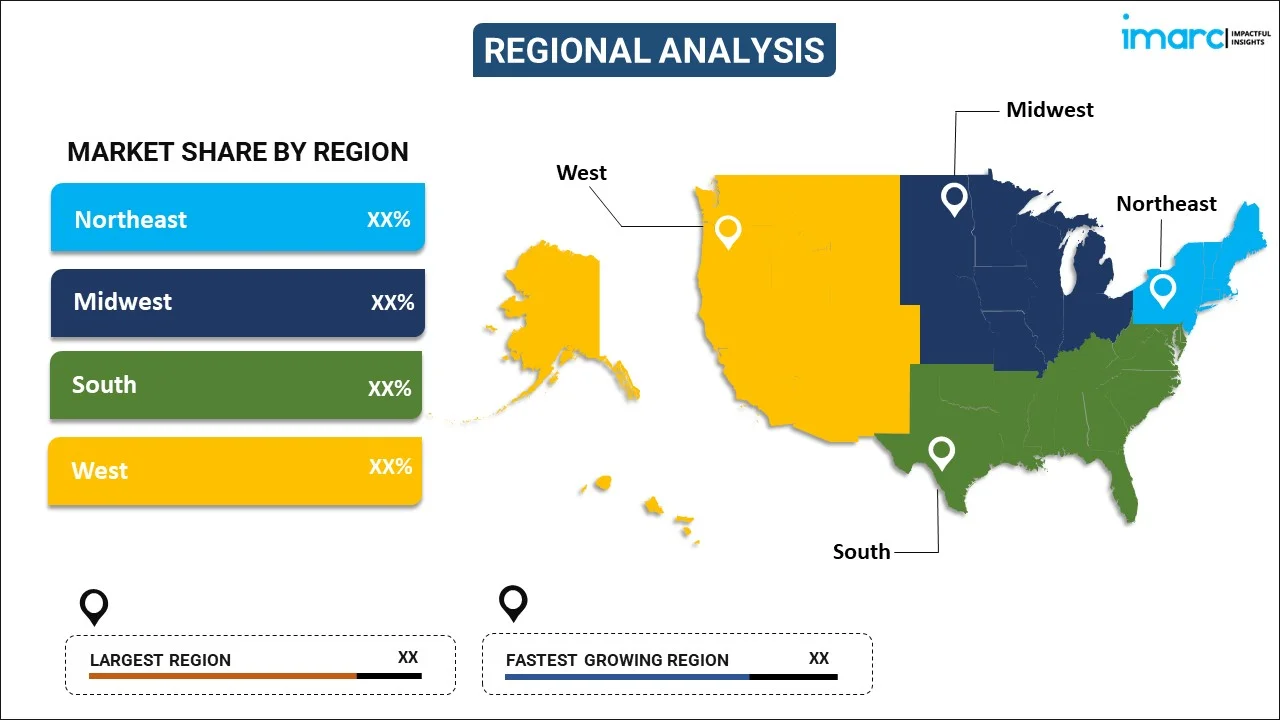
United States Trout Market Report by Trout Type (Rainbow Trout, Ohrid Trout, Sea Trout, Golden Trout, Brook Trout, and Others), Trout Size (Large, Small), Distribution (Foodservice, Retail), Form (Fresh, Frozen, Canned, and Others), and Region 2025-2033
Market Overview:
The United States trout market size reached USD 323.7 Million in 2024. Looking forward, IMARC Group expects the market to reach USD 489.4 Million by 2033, exhibiting a growth rate (CAGR) of 4.5% during 2025-2033. The augmenting demand for nutritious protein sources among the masses, considerable increase in seafood consumption, rising consumer preference towards sustainably sourced seafood, and the emerging trend of culinary tourism represent some of the key factors driving the market.
|
Report Attribute
|
Key Statistics
|
|---|---|
|
Base Year
|
2024 |
|
Forecast Years
|
2025-2033
|
|
Historical Years
|
2019-2024
|
| Market Size in 2024 | USD 323.7 Million |
| Market Forecast in 2033 | USD 489.4 Million |
| Market Growth Rate (2025-2033) | 4.5% |
Trout is a highly popular fish species that is renowned for its delicate flavor, firm texture, and nutritional value. It belongs to the Salmonidae family and is known for its unique characteristics that set it apart from other fish. Trout are predominantly found in freshwater environments such as rivers, lakes, and streams, although certain species have been successfully introduced to saltwater habitats. With its distinctive pinkish hue and silver skin adorned with black spots, trout is a visually striking species. The flavor profile of trout varies depending on the specific type and its environment, but it is generally described as mild, slightly sweet, and buttery. Its firm flesh holds up well to grilling, smoking, baking, and pan-frying methods, allowing for a wide range of delicious dishes to be created. In addition to this, its ability to absorb flavors makes it an excellent canvas for seasoning and marinades and a versatile ingredient for various culinary preparations. Furthermore, trout is an abundant source of high-quality protein, omega-3 fatty acids, and essential vitamins and minerals, making it a popular choice for health-conscious individuals seeking a nutritious diet.
United States Trout Market Trends:
The market in the United States is primarily driven by the augmenting demand for nutritious protein sources among the masses. This can be attributed to the rising number of consumers prioritizing healthy eating habits. In line with this, the considerable increase in seafood consumption, impelled by shifting dietary preferences and a desire for a balanced diet is creating lucrative opportunities in the market. With increased environmental concerns, consumers are increasingly preferring sustainably sourced seafood, which is fueling the demand for responsibly harvested species such as trout. Moreover, the increasing application of advanced vertical farming techniques in the aquaculture industry to contribute to a steady supply of fresh and high-quality fish is fueling the market. The flourishing restaurant industry, with a particular emphasis on seafood establishments, is resulting in an augmented demand for premium trout products. Furthermore, the increasing prevalence of convenience-oriented lifestyle of modern consumers is driving the demand for processed trout products such as fillets, smoked trout, and ready-to-cook options, thereby stimulating the market. Apart from this, the emerging trend of culinary tourism along with the increasing popularity of authentic food experiences are contributing to the demand for locally sourced trout in the United States. Some of the other factors creating a positive outlook for the market include continual innovations in processing and packaging technologies, favorable government initiatives promoting sustainable fishing practices, rising demand for exports, and strategic advertising and marketing campaigns conducted by the key players.
United States Trout Market Segmentation:
IMARC Group provides an analysis of the key trends in each segment of the United States trout market report, along with forecasts at the country level for 2025-2033. Our report has categorized the market based on trout type, trout size, distribution, and form.
Trout Type Insights:

- Rainbow Trout
- Ohrid Trout
- Sea Trout
- Golden Trout
- Brook Trout
- Others
The report has provided a detailed breakup and analysis of the market based on the trout type. This includes rainbow trout, ohrid trout, sea trout, golden trout, brook trout, and others.
Trout Size Insights:
- Large
- Small
A detailed breakup and analysis of the market based on the trout size has also been provided in the report. This includes large and small.
Distribution Insights:
- Foodservice
- Retail
- Supermarkets and Hypermarkets
- Convenience Stores
- Specialty Outlets
- Online Channels
- Others
The report has provided a detailed breakup and analysis of the market based on the distribution. This includes foodservice and retail (supermarkets and hypermarkets, convenience stores, specialty outlets, online channels, and others).
Form Insights:
- Fresh
- Frozen
- Canned
- Others
A detailed breakup and analysis of the market based on the form has also been provided in the report. This includes fresh, frozen, canned, and others.
Regional Insights:

- Northeast
- Midwest
- South
- West
The report has also provided a comprehensive analysis of all the major regional markets, which include Northeast, Midwest, South, and West.
Competitive Landscape:
The report has also provided a comprehensive analysis of the competitive landscape in the United States trout market. Competitive analysis such as market structure, key player positioning, top winning strategies, competitive dashboard, and company evaluation quadrant has been covered in the report. Also, detailed profiles of all major companies have been provided.
United States Trout Market Report Coverage:
| Report Features | Details |
|---|---|
| Base Year of the Analysis | 2024 |
| Historical Period | 2019-2024 |
| Forecast Period | 2025-2033 |
| Units | Million USD |
| Scope of the Report | Exploration of Historical and Forecast Trends, Industry Catalysts and Challenges, Segment-Wise Historical and Predictive Market Assessment:
|
| Trout Types Covered | Rainbow Trout, Ohrid Trout, Sea Trout, Golden Trout, Brook Trout, Others |
| Trout Sizes Covered | Large, Small |
| Distributions Covered |
|
| Forms Covered | Fresh, Frozen, Canned, Others |
| Regions Covered | Northeast, Midwest, South, West |
| Customization Scope | 10% Free Customization |
| Post-Sale Analyst Support | 10-12 Weeks |
| Delivery Format | PDF and Excel through Email (We can also provide the editable version of the report in PPT/Word format on special request) |
Key Questions Answered in This Report:
- How has the United States trout market performed so far and how will it perform in the coming years?
- What has been the impact of COVID-19 on the United States trout market?
- What is the breakup of the United States trout market on the basis of trout type?
- What is the breakup of the United States trout market on the basis of trout size?
- What is the breakup of the United States trout market on the basis of distribution?
- What is the breakup of the United States trout market on the basis of form?
- What are the various stages in the value chain of the United States trout market?
- What are the key driving factors and challenges in the United States trout market?
- What is the structure of the United States trout market and who are the key players?
- What is the degree of competition in the United States trout market?
Key Benefits for Stakeholders:
- IMARC’s report offers a comprehensive quantitative analysis of various market segments, historical and current market trends, market forecasts, and dynamics of the United States trout market from 2019-2033.
- The research study provides the latest information on the market drivers, challenges, and opportunities in the United States trout market.
- Porter's five forces analysis assist stakeholders in assessing the impact of new entrants, competitive rivalry, supplier power, buyer power, and the threat of substitution. It helps stakeholders to analyze the level of competition within the United States trout industry and its attractiveness.
- Competitive landscape allows stakeholders to understand their competitive environment and provides an insight into the current positions of key players in the market.
Need more help?
- Speak to our experienced analysts for insights on the current market scenarios.
- Include additional segments and countries to customize the report as per your requirement.
- Gain an unparalleled competitive advantage in your domain by understanding how to utilize the report and positively impacting your operations and revenue.
- For further assistance, please connect with our analysts.
 Inquire Before Buying
Inquire Before Buying
 Speak to an Analyst
Speak to an Analyst
 Request Brochure
Request Brochure
 Request Customization
Request Customization




.webp)




.webp)












